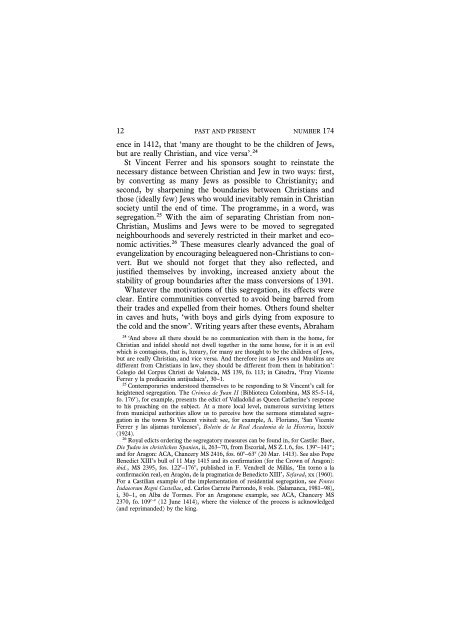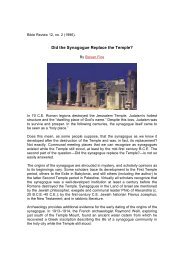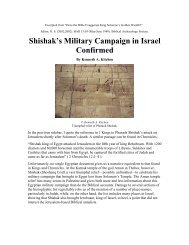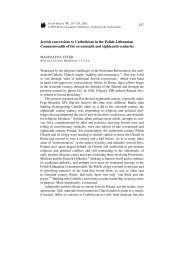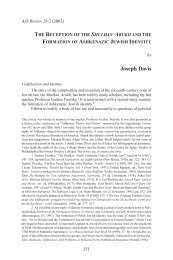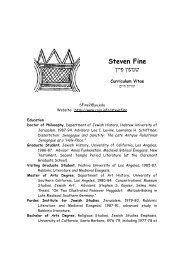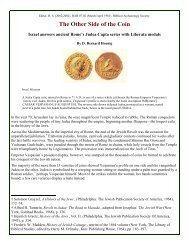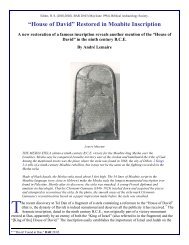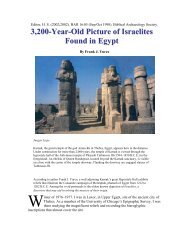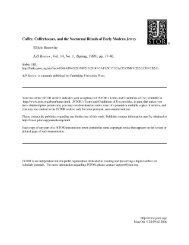jews and christians in fifteenth-century spain
jews and christians in fifteenth-century spain
jews and christians in fifteenth-century spain
Create successful ePaper yourself
Turn your PDF publications into a flip-book with our unique Google optimized e-Paper software.
12 PAST AND PRESENT NUMBER 174<br />
ence <strong>in</strong> 1412, that ‘many are thought to be the children of Jews,<br />
but are really Christian, <strong>and</strong> vice versa’.24<br />
St V<strong>in</strong>cent Ferrer <strong>and</strong> his sponsors sought to re<strong>in</strong>state the<br />
necessary distance between Christian <strong>and</strong> Jew <strong>in</strong> two ways: first,<br />
by convert<strong>in</strong>g as many Jews as possible to Christianity; <strong>and</strong><br />
second, by sharpen<strong>in</strong>g the boundaries between Christians <strong>and</strong><br />
those (ideally few) Jews who would <strong>in</strong>evitably rema<strong>in</strong> <strong>in</strong> Christian<br />
society until the end of time. The programme, <strong>in</strong> a word, was<br />
segregation.25 With the aim of separat<strong>in</strong>g Christian from non-<br />
Christian, Muslims <strong>and</strong> Jews were to be moved to segregated<br />
neighbourhoods <strong>and</strong> severely restricted <strong>in</strong> their market <strong>and</strong> economic<br />
activities.26 These measures clearly advanced the goal of<br />
evangelization by encourag<strong>in</strong>g beleaguered non-Christians to convert.<br />
But we should not forget that they also reflected, <strong>and</strong><br />
justified themselves by <strong>in</strong>vok<strong>in</strong>g, <strong>in</strong>creased anxiety about the<br />
stability of group boundaries after the mass conversions of 1391.<br />
Whatever the motivations of this segregation, its effects were<br />
clear. Entire communities converted to avoid be<strong>in</strong>g barred from<br />
their trades <strong>and</strong> expelled from their homes. Others found shelter<br />
<strong>in</strong> caves <strong>and</strong> huts, ‘with boys <strong>and</strong> girls dy<strong>in</strong>g from exposure to<br />
the cold <strong>and</strong> the snow’. Writ<strong>in</strong>g years after these events, Abraham<br />
24 ‘And above all there should be no communication with them <strong>in</strong> the home, for<br />
Christian <strong>and</strong> <strong>in</strong>fidel should not dwell together <strong>in</strong> the same house, for it is an evil<br />
which is contagious, that is, luxury, for many are thought to be the children of Jews,<br />
but are really Christian, <strong>and</strong> vice versa. And therefore just as Jews <strong>and</strong> Muslims are<br />
different from Christians <strong>in</strong> law, they should be different from them <strong>in</strong> habitation’:<br />
Colegio del Corpus Christi de Valencia, MS 139, fo. 113; <strong>in</strong> Cátedra, ‘Fray Vicente<br />
Ferrer y la predicación antijudaica’, 30–1.<br />
25 Contemporaries understood themselves to be respond<strong>in</strong>g to St V<strong>in</strong>cent’s call for<br />
heightened segregation. The Crónica de Juan II (Biblioteca Colomb<strong>in</strong>a, MS 85-5-14,<br />
fo. 176r), for example, presents the edict of Valladolid as Queen Cather<strong>in</strong>e’s response<br />
to his preach<strong>in</strong>g on the subject. At a more local level, numerous surviv<strong>in</strong>g letters<br />
from municipal authorities allow us to perceive how the sermons stimulated segregation<br />
<strong>in</strong> the towns St V<strong>in</strong>cent visited: see, for example, A. Floriano, ‘San Vicente<br />
Ferrer y las aljamas turolenses’, Boletín de la Real Academia de la Historia, lxxxiv<br />
(1924).<br />
26 Royal edicts order<strong>in</strong>g the segregatory measures can be found <strong>in</strong>, for Castile: Baer,<br />
Die Juden im christlichen Spanien, ii, 263–70, from Escorial, MS Z.1.6, fos. 139v–141v;<br />
<strong>and</strong> for Aragon: ACA, Chancery MS 2416, fos. 60v–63v (20 Mar. 1413). See also Pope<br />
Benedict XIII’s bull of 11 May 1415 <strong>and</strong> its confirmation (for the Crown of Aragon):<br />
ibid., MS 2395, fos. 122r–176v, published <strong>in</strong> F. Vendrell de Millás, ‘En torno a la<br />
confirmación real, en Aragón, de la pragmatica de Benedicto XIII’, Sefarad, xx (1960).<br />
For a Castilian example of the implementation of residential segregation, see Fontes<br />
Iudaeorum Regni Castellae, ed. Carlos Carrete Parrondo, 8 vols. (Salamanca, 1981–98),<br />
i, 30–1, on Alba de Tormes. For an Aragonese example, see ACA, Chancery MS<br />
2370, fo. 109r–v (12 June 1414), where the violence of the process is acknowledged<br />
(<strong>and</strong> reprim<strong>and</strong>ed) by the k<strong>in</strong>g.


